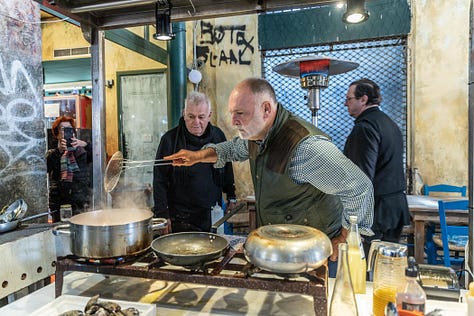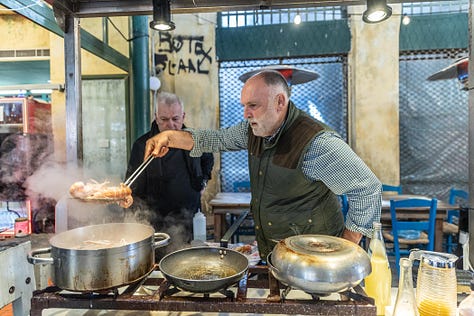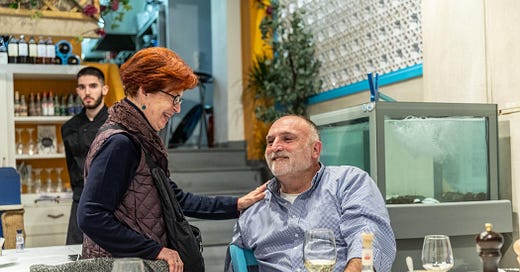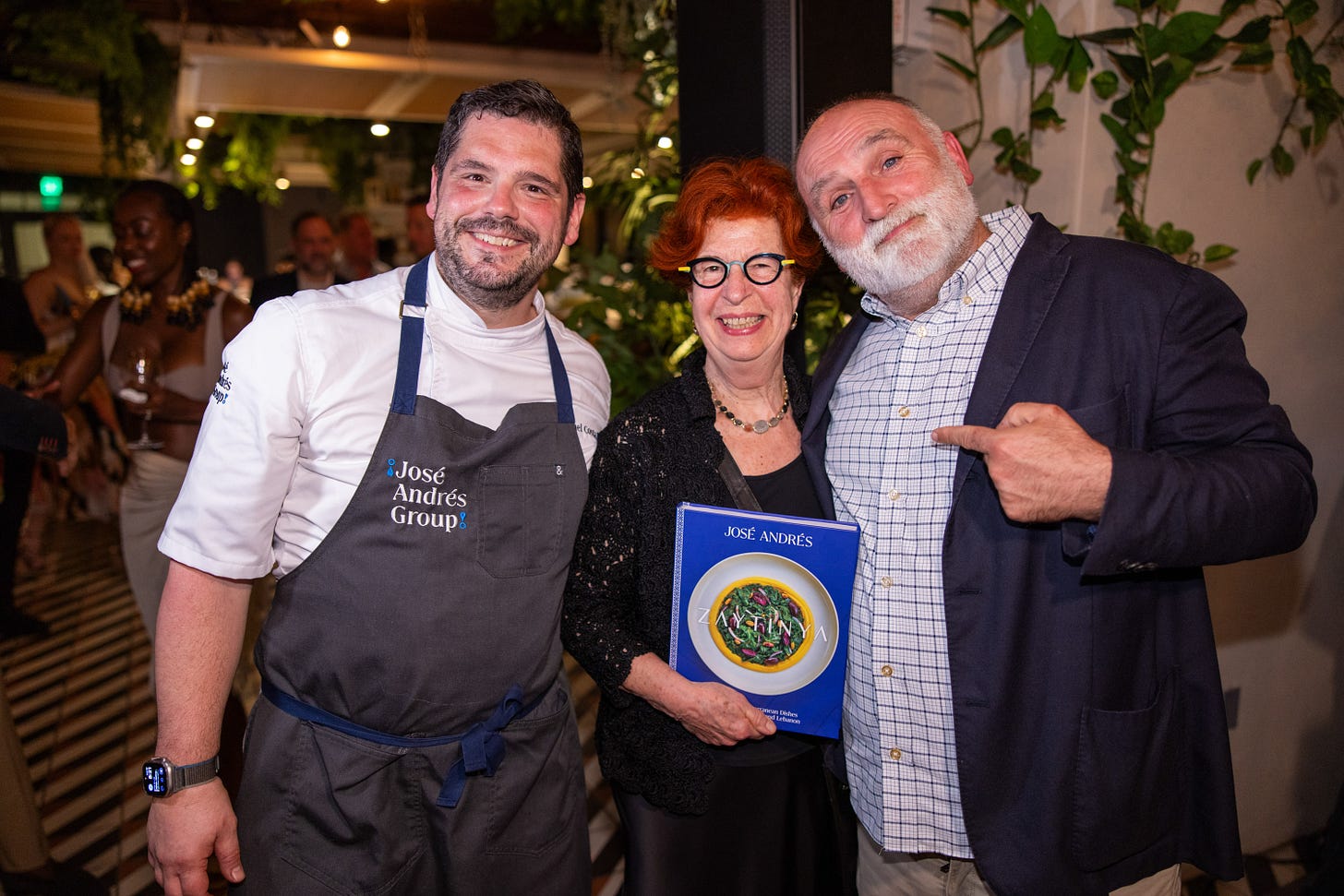A conversation with my "Greek grandmother"
Aglaia Kremezi has been with me since the beginning
Hola friends, I hope you all had a great weekend! Here in DC, we are getting ready to celebrate the Cherry Blossom festival, which marks the beginning of spring. Although the blooms aren’t out yet, I’ll be back in touch next week about some of the things that my restaurants are doing to celebrate…and maybe with a recipe! I also hope some of you joined me for the very first Grubstack, and saw my conversation with the amazing Ruth Rogers. Even though we had some technical difficulties, we had a great time, and you should check out her Substack when you have a chance!
Today I want to talk about someone who has been very important to me for a very long time, someone who helped me with not just the concept of Zaytinya, but also its ongoing success and evolution. I’m talking about my friend and Zaytinya’s “Greek Grandmother,” Aglaia Kremezi! Aglaia is a writer, journalist, photographer, and an amazing cook…she’s an expert on Greek food, and was very important in bringing Greek food to the American table. She also wrote the introduction to the Zaytinya cookbook…if you already have it, you should give it another read. And if you don’t, well…spring is the perfect time to start bringing some Greek food into your life!
I first met Aglaia about 20 years ago on her home island of Kea, when I was researching ideas for Zaytinya, and we immediately became friends. We ate at taverns and I tried everything I could. She took me to markets, and most importantly she helped me understand the spirit of Greek cooking—a spirit, more often than not, embodied by the women of Greece. The women are the beating hearts and souls of Greek food, and because I’ve wanted to feature some of the amazing women at the hearts and souls of my restaurants, I couldn’t let March go by without introducing you to Aglaia.
Let’s hear from her, in her own words, about how we met, her continued involvement in Zaytinya, her thoughts on Greek food in the U.S., and what she’s been up to since we first met! And of course, if you love her as much as I do, you should subscribe to her newsletter for more inspiration:
Longer Tables: How did you become involved with Zaytinya, and how have you stayed involved through the years?
Aglaia: José was looking for somebody to give him an insight into Greek cooking as he was preparing to open Zaytinya, and our mutual friend, Mark Furstenberg (an amazing DC baker), suggested we meet. José called me because he was already traveling around the Eastern Mediterranean, doing research, and he had been in Lebanon and Turkey, so he suggested we meet in Athens. I said, “I’m not in Athens!” I explained to him where I live—on the beautiful island of Kea, about an hour from Athens by ferry—and we agreed to meet where the ferry arrived. He said I wouldn't have a hard time recognizing him, because he looked American!
We spent a few days here going around taverns and cooking together. He showed me a lot of the photos he’d taken in Turkey and Lebanon—fabulous pictures of things he’d seen and tasted. So we spent a lot of time eating and cooking together, and he decided I would be the person he would talk to about all things Greek food.
How has the perception of Greek food changed—both in the US and throughout the world?
I think some of it has to do with people traveling to Greece, and it being an increasingly popular vacation destination. But also at the time he was thinking about Zaytinya—in the late 90’s and early 00’s—chefs were starting to experiment with Greek food. They wanted to do something different, maybe something besides Italian, but it took some time. I was the consultant for some of the very first upscale Greek restaurants in the US, and I worked with chefs to translate traditional Greek food into something that you could see on a table in an upscale restaurant in midtown Manhattan. But it felt like a natural transition in some ways, because people wanted to cook that way.
Lots of people here understand more about Greek food now, but so much of it is in the context of “meze.” What does “meze” mean to you?
You see this a lot in Spain too, and a lot of other food cultures, but ultimately it’s a product of what we have in season. When you go back into Greek history, people were usually really poor, but they wanted to take care of their guests, anyone stopping by. So they would make small dishes with whatever they had to feed guests, along with a drink…a few olives, a little bit of cheese, some kind of spreads. There is also this longstanding Greek tradition where you don’t drink without eating—it goes back to ancient texts! So I think that’s how meze started, and then it became a way of eating here. I’ve been to houses, for example, where they had leftover meat from the day before, they put it on a slice of bread and add a little olive oil or onion, and that’s a meze. It’s a little different here now, because tourism is so much more prevalent, and now places here take ideas that they see in Greek restaurants in Paris or New York.
How do you stay engaged with the creative process at Zaytinya?
Aglaia:
I speak with (Zaytinya’s concept chef) Michael Costa almost every week to exchange ideas. It’s not always about a specific dish, but the exchange of information leads to really creative things. I’ve never seen that with any other chef that I’ve worked with…he really wants to invest the time to get it right. José does that too—not that there’s a right way or a wrong way, but they’re interested in learning the traditional way and then go from there. If you know how something is made traditionally, you can be creative and really invent anything.
A great example of this is something I talked about recently in my newsletter—we were talking about spanakopita. And one of the first things I ever said to José was “don’t even think about doing a Greek or Eastern Mediterranean restaurant without rolling your own phyllo.” And he really understood that immediately—and he found the amazing Abedelrazzaq Hashhoush, who grew up in Lebanon and is a master of phyllo. He tought José and his team at Zaytinya to properly roll out paper-thin phyllo, and I don’t think too many other restaurants are doing that.
These days I’ve been learning a lot about the food in Kalamata, and how cooks there make their sauces with fish—there’s a tomato sauce with raisins, so that’s really interesting. I’m always learning…and I share a lot of that with Michael.
What is one of your best travel memories of José?



I remember the last time José visited, when he was doing research for the Zaytinya cookbook and we went to the central fish market of Athens. He went crazy because he found these cigalas, which are Norwegian lobsters. He just loves them, and the price here was much lower than in Spain. He said, "Oh my god," and bought a bag and then he went to one of the restaurants of the market and he convinced them to give him a pan. He started cooking them right there in the market, showed them different ways they could be cooked, and he was in his element. Deep inside he loves to get into the kitchen and get a pan and start cooking. Believe me, I’ve met a lot of chefs, and that’s not a common thing.
Since it’s Women’s History Month, can you talk about your experience as a woman in Greece—as a journalist, photographer, and cook?
Aglaia:
Unfortunately it’s still not easy as a woman in Greece—as a young journalist and photographer, I was encouraged to only cover fashion. But I never had a problem, because I was a very pushy person anyway! I wouldn’t take no for an answer. But I’ve heard from many Greek women chefs and cooks that they had a difficult time. And it’s interesting because in most cases the family-owned restaurants relied…and still rely on…the mother, or grandmother, who cooks, and she’s the invisible hero of the kitchen. The men go out to the front of the house, but the women are the cooks.

Women are starting to come out of the shadows, Greek women who are chefs have gotten Michelin stars, but in most places, the beating heart and soul of the Greek kitchen is most likely a woman.
José here again—how amazing is my friend Aglaia? If you get a chance, please subscribe to her Substack newsletter (last week she published a recipe for spanikopita using tortillas!), and check out her cookbooks. As the weather heats up and you might be exploring new recipes, you can bring the Greek grandmother into your home with her work. I am so happy to know her, and I know you will be, too!







Love Aglaia and Costas. Your article brought back memories of a wonderful visit to Kea and a blissful day soaking up their hospitality and knowledge. Aren’t we lucky to have her in our culinary circle. Travel with her always informed and fun. Thank you for this special interview.
Love this! Thank you for sharing so much goodness.